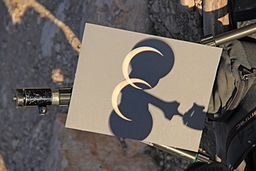¡SkyCaramba! Weekly astronomy blog for the week ending May 11, 2013
 On May 10 this year, people who can look toward the sun along a certain path crossing northern Australia and reaching far into the Pacific Ocean will see a so-called ring of fire eclipse. An annular eclipse of the sun happens when the moon passes right in front of the sun, but the moon’s disk doesn’t appear big enough to complete block the sun’s disk. Instead, the sun’s disk surrounds the moon’s disk.
On May 10 this year, people who can look toward the sun along a certain path crossing northern Australia and reaching far into the Pacific Ocean will see a so-called ring of fire eclipse. An annular eclipse of the sun happens when the moon passes right in front of the sun, but the moon’s disk doesn’t appear big enough to complete block the sun’s disk. Instead, the sun’s disk surrounds the moon’s disk.
Since it’s not a total eclipse, there’s never a moment when it’s completely safe to see the annular eclipse of the sun without protecting your eyes. The amount of sunlight you see may not be bright enough to make you feel pain. But there’s still plenty of invisible infrared and ultraviolet coming from our home star to damage your eyes. So take precaution.
 There are various ways of projecting an image of the sun. The easiest is through a pinhole in a sheet of stiff paper. You can even make a pinhole viewer box that you look into so the image you see is projected in darkness like a movie on a movie theater screen.
There are various ways of projecting an image of the sun. The easiest is through a pinhole in a sheet of stiff paper. You can even make a pinhole viewer box that you look into so the image you see is projected in darkness like a movie on a movie theater screen.
Another involves using a telescope or binoculars to project a much brighter image of the sun onto a surface such as a sidewalk or a piece of paper. That can be tricky. You NEVER should look through the telescope or binoculars to point the instrument for projecting the sun. You have to do it by minimizing the instrument’s shadow and maybe a little guess now and then about which way to nudge it until the sun’s disk becomes visible on whatever surface is your viewing screen. Looking through the telescope or  binoculars without a solar filter will blind you, probably permanently. You also have to be careful that the magnified sunlight isn’t causing damage insight the instrument. If you have any doubts about your ability to use this method, don’t try.
binoculars without a solar filter will blind you, probably permanently. You also have to be careful that the magnified sunlight isn’t causing damage insight the instrument. If you have any doubts about your ability to use this method, don’t try.
A really good way—one that will allow you to safely look through the telescope or binoculars—is to use a solar filter. The filter blocks all but a tiny fraction of one percent of the sun’s light from going into the instrument in the first place. The light that gets through isn’t strong enough to melt anything inside the telescope. Nor will it hurt your eyes. Of course, you must make sure the filter is properly installed. It must fit snugly and it mustn’t be damaged in any way while you are using it.
Using the Universal Time zone, the eclipse of May 10 starts on the 9th. It will already be the 10th in the local time zones, however. The path of annularity crosses the northern provinces of Australia and heads to the Solomon Islands. The greatest eclipse happens at 0:24 UT in the islands of Kiribati. The path of annularity curves to its northernmost region northeast of Howland and Baker islands. It ends in the Marquesas Islands regions.
For hundreds of miles to the north and south of the path of annularity, people will be able to see a partial solar eclipse. If you are in any part of the visibility area, I wish you good viewing. ¡SkyCaramba!
http://eclipse.gsfc.nasa.gov/SEgoogle/SEgoogle2001/SE2013May10Agoogle.html
http://www.eclipse.aaq.org.au/index.php/eclipse-information/annular-solar-eclipse-10-may-2013